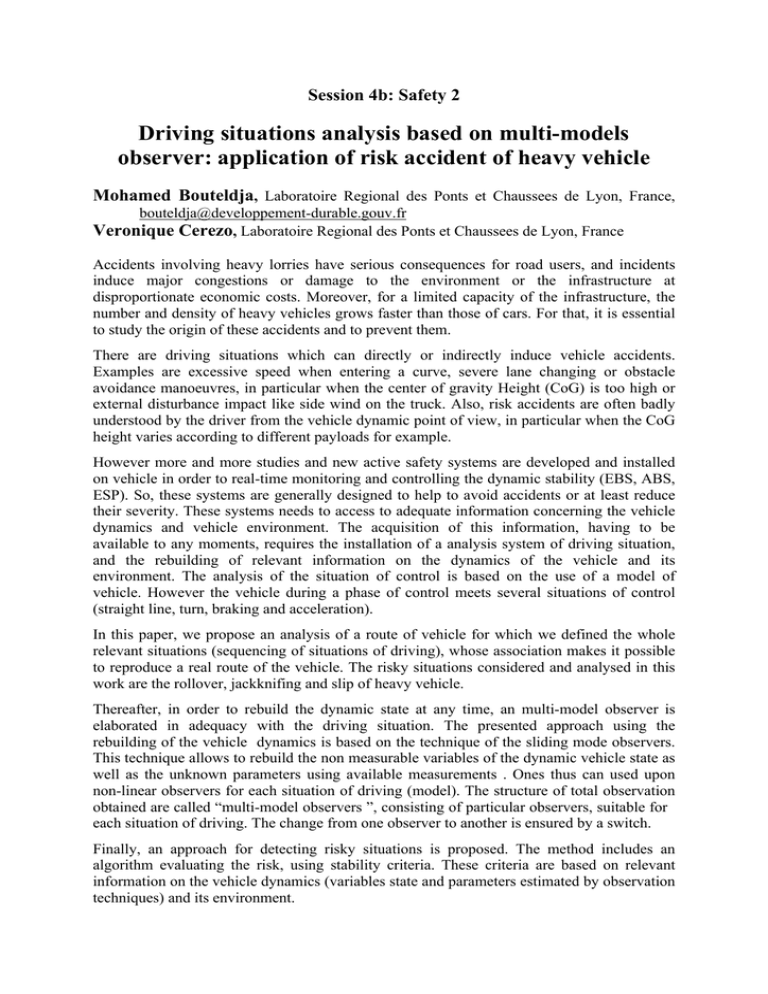Driving situations analysis based on multi-models
advertisement

Session 4b: Safety 2 Driving situations analysis based on multi-models observer: application of risk accident of heavy vehicle Mohamed Bouteldja, Laboratoire Regional des Ponts et Chaussees de Lyon, France, bouteldja@developpement-durable.gouv.fr Veronique Cerezo, Laboratoire Regional des Ponts et Chaussees de Lyon, France Accidents involving heavy lorries have serious consequences for road users, and incidents induce major congestions or damage to the environment or the infrastructure at disproportionate economic costs. Moreover, for a limited capacity of the infrastructure, the number and density of heavy vehicles grows faster than those of cars. For that, it is essential to study the origin of these accidents and to prevent them. There are driving situations which can directly or indirectly induce vehicle accidents. Examples are excessive speed when entering a curve, severe lane changing or obstacle avoidance manoeuvres, in particular when the center of gravity Height (CoG) is too high or external disturbance impact like side wind on the truck. Also, risk accidents are often badly understood by the driver from the vehicle dynamic point of view, in particular when the CoG height varies according to different payloads for example. However more and more studies and new active safety systems are developed and installed on vehicle in order to real-time monitoring and controlling the dynamic stability (EBS, ABS, ESP). So, these systems are generally designed to help to avoid accidents or at least reduce their severity. These systems needs to access to adequate information concerning the vehicle dynamics and vehicle environment. The acquisition of this information, having to be available to any moments, requires the installation of a analysis system of driving situation, and the rebuilding of relevant information on the dynamics of the vehicle and its environment. The analysis of the situation of control is based on the use of a model of vehicle. However the vehicle during a phase of control meets several situations of control (straight line, turn, braking and acceleration). In this paper, we propose an analysis of a route of vehicle for which we defined the whole relevant situations (sequencing of situations of driving), whose association makes it possible to reproduce a real route of the vehicle. The risky situations considered and analysed in this work are the rollover, jackknifing and slip of heavy vehicle. Thereafter, in order to rebuild the dynamic state at any time, an multi-model observer is elaborated in adequacy with the driving situation. The presented approach using the rebuilding of the vehicle dynamics is based on the technique of the sliding mode observers. This technique allows to rebuild the non measurable variables of the dynamic vehicle state as well as the unknown parameters using available measurements . Ones thus can used upon non-linear observers for each situation of driving (model). The structure of total observation obtained are called “multi-model observers ”, consisting of particular observers, suitable for each situation of driving. The change from one observer to another is ensured by a switch. Finally, an approach for detecting risky situations is proposed. The method includes an algorithm evaluating the risk, using stability criteria. These criteria are based on relevant information on the vehicle dynamics (variables state and parameters estimated by observation techniques) and its environment.





